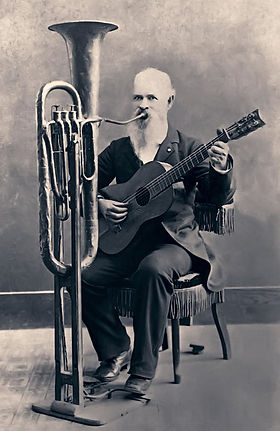Tuba machine
Frog&Henry built a foot-operated tuba machine so that a single person could play tuba and guitar at the same time: a one-man rhythm section.
And the idea came from this photograph.
In 1890, C.W.J. Johnson invented a mechanized foot-operated bass brass instrument. He's shown here playing an upright 3 Berliner valve Eb contrabass Saxhorn while playing guitar with his hands. We're the only group who has made and used one since this photo was taken.
Frog&Henry's tuba machine has a fully chromatic pedal system, capable of playing any note a hand-operated tuba would; and the majority of the tuba's entire repertoire can be played by foot.
C.W.J. Johnson's tuba-machine has only two foot-pedals (acting on two valves: 1&3). This means that he would have been missing any notes involving valve 2. It also looks like he modified the lead pipe to allow enough clearance between his body and the bottom of the bell to hold a guitar and sit comfortably while playing both instruments.
One of the most significant ergonomic challenges that we encountered was to activate all three tuba valves, and acheive all 6 possible valve-combinations with only three foot-pedals. Added to this challenge is the necessity of planting both heels on the ground for balance while playing. The foot obviously doesn't behave like a hand: it can't hover over the pedals; and it doesn't really have independent digits. Our first design had the heel&toe of one foot activating valves 1 and 3 and valve 2 with the toe of the other. But it's just too much of a strain physiologically to have one leg hovering in the air for hours at a time, not to mention the obvious effect this posture has on balance while playing. Three points of contact are absolutely necessary for balance when seated; that's why both heels need to be planted.
We found we had to incorporate a knee-lever to operate one valve, with the other two activated by foot. We took the knee-lever mechanism directly out of a lap-steel. And we're still testing to see if it really works.


Fotdella
Sometimes, very rarely, featured in Frog & Henry is the fotdella. It's a foot-operated string bass invented in the 1950's by Jesse Fuller, a one-man-band, as seen in this photograph:

There are three fotdellas, that we've built, out there: two of which are in North Italy. Normally they're constructed from an upright bass already missing its neck and headstock, and from the keyboard mechanism of a piano. In the interest of avoiding waste, the component parts of the fotdella are always taken from instruments that are no longer playable as the instrument they were originally designed and built to be. There are enough very well crafted pianos being given away at this point in history that there's no need to dismantle a playable instrument. A defunct upright bass body can normally be purchased for about $300 or less. The most common break on an upright bass is at the point where the neck joins the body; and it's normally the neck that's broken. It's not beyond anyone's means to build their own neck in order to make a fotdella. It just involves some figuring, a few careful cuts, and a bunch of sanding.
The one in the bottom center, in the pictures below, is the latest design and sounds the best since, apart from the fact that the strings are plucked instead of struck by piano hammers, the string length is the same as that of a contrabass: and the bridge is also in its intended position on the body of the instrument. It actually sounds like there's a person playing it with their fingers when it's in action. Presumably, there does not exist another one with the mechanism for plucking the strings but it is similar to an enlarged harpsichord jack. Frog & Henry built this one in Belgium, at home, in 2018 over the course of four months. The neck and bridge were custom made to accommodate nine strings. The pedal box is from a sewing machine. The jacks are operated by bicycle cables; and the cables can be any length which provides the advantage of being able to place the body of the instrument literally anywhere in relation to the player (as opposed to being in a fixed, face-on, position like the original design).
If you'd like any more information about any aspect of this instrument, please contact info@frogandhenry.com.







